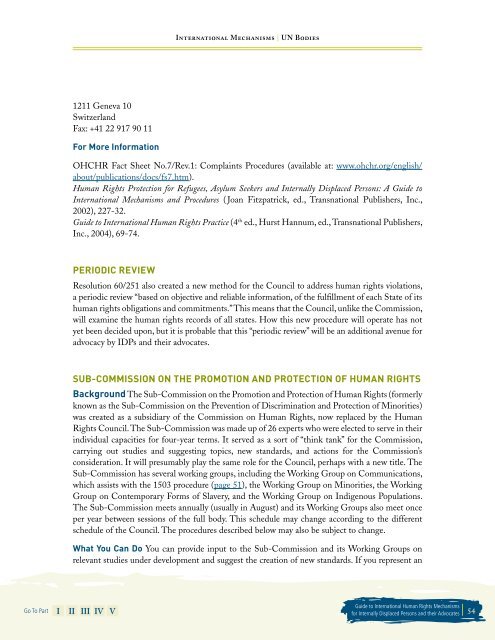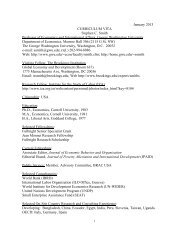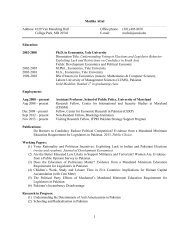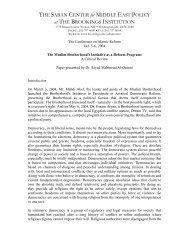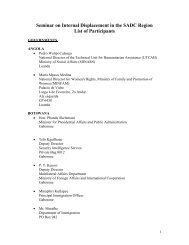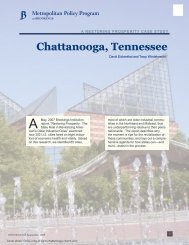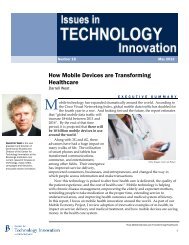Guide to International Human Rights Mechanisms - Brookings
Guide to International Human Rights Mechanisms - Brookings
Guide to International Human Rights Mechanisms - Brookings
Create successful ePaper yourself
Turn your PDF publications into a flip-book with our unique Google optimized e-Paper software.
1211 Geneva 10<br />
Switzerland<br />
Fax: +41 22 917 90 11<br />
Go To Part I II III IV V<br />
for more information<br />
<strong>International</strong> <strong>Mechanisms</strong> | UN Bodies<br />
OHCHR Fact Sheet No.7/Rev.1: Complaints Procedures (available at: www.ohchr.org/english/<br />
about/publications/docs/fs7.htm).<br />
<strong>Human</strong> <strong>Rights</strong> Protection for Refugees, Asylum Seekers and Internally Displaced Persons: A <strong>Guide</strong> <strong>to</strong><br />
<strong>International</strong> <strong>Mechanisms</strong> and Procedures ( Joan Fitzpatrick, ed., Transnational Publishers, Inc.,<br />
2002), 227-32.<br />
<strong>Guide</strong> <strong>to</strong> <strong>International</strong> <strong>Human</strong> <strong>Rights</strong> Practice (4 th ed., Hurst Hannum, ed., Transnational Publishers,<br />
Inc., 2004), 69-74.<br />
PerioDic revieW<br />
Resolution 60/251 also created a new method for the Council <strong>to</strong> address human rights violations,<br />
a periodic review “based on objective and reliable information, of the fulfillment of each State of its<br />
human rights obligations and commitments.” This means that the Council, unlike the Commission,<br />
will examine the human rights records of all states. How this new procedure will operate has not<br />
yet been decided upon, but it is probable that this “periodic review” will be an additional avenue for<br />
advocacy by IDPs and their advocates.<br />
suB-commission on The PromoTion anD ProTecTion of human righTs<br />
Background The Sub-Commission on the Promotion and Protection of <strong>Human</strong> <strong>Rights</strong> (formerly<br />
known as the Sub-Commission on the Prevention of Discrimination and Protection of Minorities)<br />
was created as a subsidiary of the Commission on <strong>Human</strong> <strong>Rights</strong>, now replaced by the <strong>Human</strong><br />
<strong>Rights</strong> Council. The Sub-Commission was made up of 26 experts who were elected <strong>to</strong> serve in their<br />
individual capacities for four-year terms. It served as a sort of “think tank” for the Commission,<br />
carrying out studies and suggesting <strong>to</strong>pics, new standards, and actions for the Commission’s<br />
consideration. It will presumably play the same role for the Council, perhaps with a new title. The<br />
Sub-Commission has several working groups, including the Working Group on Communications,<br />
which assists with the 1503 procedure (page 51), the Working Group on Minorities, the Working<br />
Group on Contemporary Forms of Slavery, and the Working Group on Indigenous Populations.<br />
The Sub-Commission meets annually (usually in August) and its Working Groups also meet once<br />
per year between sessions of the full body. This schedule may change according <strong>to</strong> the different<br />
schedule of the Council. The procedures described below may also be subject <strong>to</strong> change.<br />
What you can Do You can provide input <strong>to</strong> the Sub-Commission and its Working Groups on<br />
relevant studies under development and suggest the creation of new standards. If you represent an<br />
<strong>Guide</strong> <strong>to</strong> <strong>International</strong> <strong>Human</strong> <strong>Rights</strong> <strong>Mechanisms</strong><br />
for Internally Displaced Persons and their Advocates


